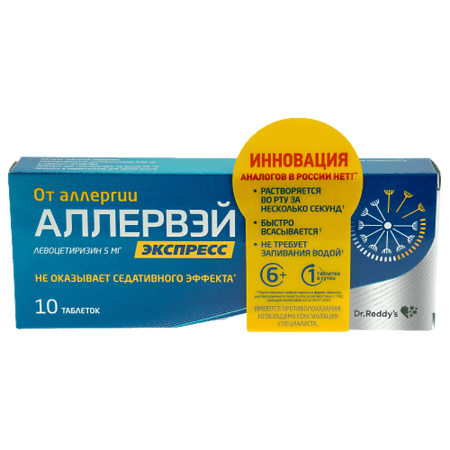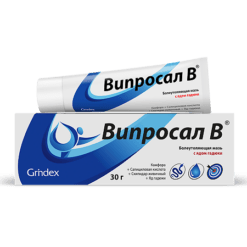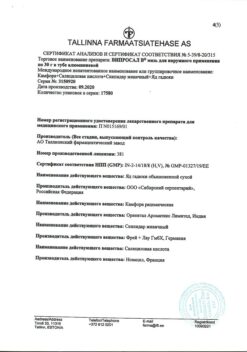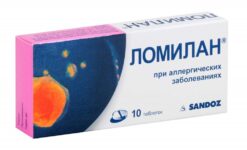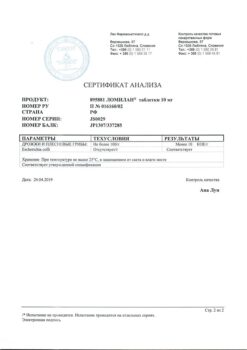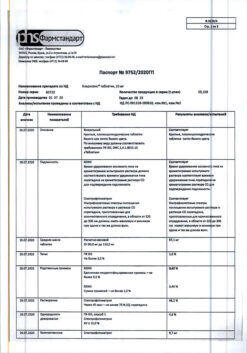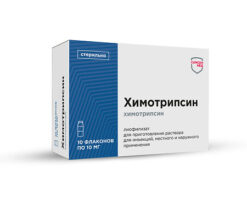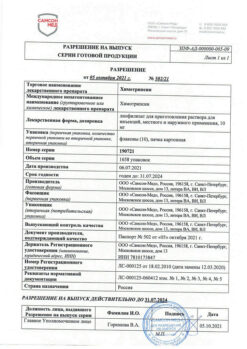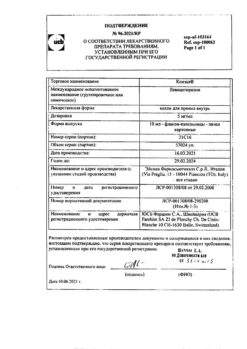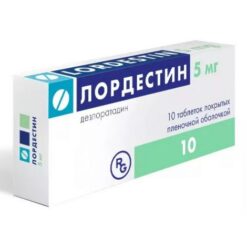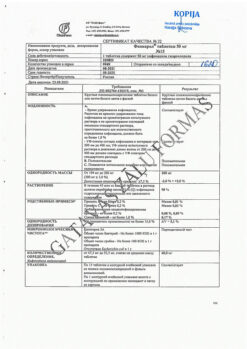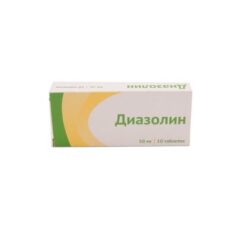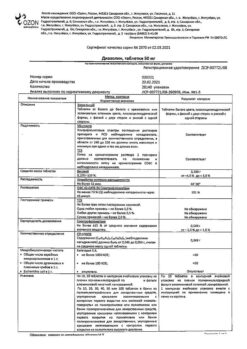No products in the cart.
Description
Pharmacotherapeutic group: anti-allergic agent – H1-histamine receptor blocker.
The ATC code: R06AE09
Pharmacological properties
Pharmacodynamics
Levocetirizine (R)-enantiomer of cetirizine is an inhibitor of peripheral H1-histamine receptors.
Levocetirizine has a pronounced antihistamine and anti-allergic effect. It influences the histamine-dependent phase of the allergic reaction, decreases migration of eosinophils, reduces the permeability of the vascular wall and limits the release of inflammatory mediators.
Levocetirizine prevents the development and facilitates allergic reactions, has antipruritic and antiexudative actions. It has practically no effect on cholinergic and serotonin receptors and has no sedative effect in therapeutic doses.
Pharmacokinetics
The pharmacokinetics of levocetirizine changes linearly.
Intake
After oral administration, the drug is quickly and completely adsorbed from the gastrointestinal tract. Food intake does not affect the completeness of absorption, although the speed of absorption is reduced. In adults, after a single therapeutic dose (5 mg) the maximum concentration (Cmax) in plasma is 270 ng/ml, reached after 0.9 hours, after reuptake in 5 mg dose – 308 ng/ml. The equilibrium plasma concentration (Css) is reached after 2 days.
Distribution
Levocetirizine is 90% bound to blood plasma proteins. Volume of distribution (Vd) is 0.4 l/kg. Bioavailability reaches 100%.
Metabolism
Less than 14% of the drug is metabolized in the body by N- and O-dealkylation (unlike other H1-histamine receptor antagonists, which are metabolized in the liver via the cytochrome system) to form a pharmacologically inactive metabolite.
Owing to limited metabolism and absence of metabolic inhibitory activity, interaction of levocetirizine at the metabolic level with other substances is unlikely.
Elimination
In adults the half-life (T1/2) is 7.9±1.9 hours, total clearance is 0.63 ml/min/kg.
About 85.4% of the administered dose is excreted unchanged by kidneys via glomerular filtration and tubular secretion; about 12.9% – via intestine.
Peculiarities of pharmacokinetics in individual patients
Patients with impaired renal function
. In patients with renal impairment (creatinine clearance (CK) < 40 ml/min) the drug clearance is decreased and T1/2 is prolonged. In patients on hemodialysis total clearance is decreased by 80%, which requires a change in dosing regimen. Less than 10% of levocetirizine is eliminated during a standard 4-hour hemodialysis procedure.
Indications
Indications
Treatment of symptoms of allergic rhinitis, including year-round (persistent) and seasonal (intermittent) allergic rhinitis, and allergic conjunctivitis, such as itching, sneezing, nasal congestion, rhinorrhea, lacrimation, conjunctival hyperemia;
hay fever (hay fever);
hives;
other allergic dermatoses accompanied by itching and rashes.
Pharmacological effect
Pharmacological effect
Pharmacotherapeutic group: antiallergic agent – H1-histamine receptor blocker.
ATX code: R06AE09
Pharmacological properties
Pharmacodynamics
Levocetirizine (R) is the enantiomer of cetirizine and is an inhibitor of peripheral H1 histamine receptors.
Levocetirizine has a pronounced antihistamine and antiallergic effect. It affects the histamine-dependent phase of the allergic reaction, reduces the migration of eosinophils, reduces the permeability of the vascular wall and limits the release of inflammatory mediators.
Levocetirizine prevents the development and alleviates the course of allergic reactions, has antipruritic and antiexudative effects. It has virtually no effect on cholinergic and serotonin receptors, and does not have a sedative effect in therapeutic doses.
Pharmacokinetics
The pharmacokinetics of levocetirizine varies linearly.
Suction
After oral administration, the drug is quickly and completely absorbed from the gastrointestinal tract. Eating does not affect the completeness of absorption, although its speed decreases. In adults, after a single dose of the drug in a therapeutic dose (5 mg), the maximum concentration (Cmax) in the blood plasma is 270 ng/ml and is achieved after 0.9 hours, after repeated administration at a dose of 5 mg – 308 ng/ml. Equilibrium plasma concentration (Css) is achieved after 2 days.
Distribution
Levocetirizine is 90% bound to plasma proteins. The volume of distribution (Vd) is 0.4 l/kg. Bioavailability reaches 100%.
Metabolism
Less than 14% of the drug is metabolized in the body by N- and O-dealkylation (unlike other H1-histamine receptor antagonists, which are metabolized in the liver using the cytochrome system) to form a pharmacologically inactive metabolite.
Due to limited metabolism and the absence of metabolic inhibitory activity, interaction of levocetirizine at the metabolic level with other substances is unlikely.
Removal
In adults, the half-life (T1/2) is 7.9 ± 1.9 hours, the total clearance is 0.63 ml/min/kg.
About 85.4% of the administered dose of the drug is excreted unchanged by the kidneys through glomerular filtration and tubular secretion; about 12.9% – through the intestines.
Features of pharmacokinetics in individual patients
Patients with impaired renal function
In patients with renal failure (creatinine clearance (CC) < 40 ml/min), drug clearance is reduced and T1/2 is prolonged. In patients on hemodialysis, total clearance is reduced by 80%, which requires a change in dosage regimen. Less than 10% of levocetirizine is removed during a standard 4-hour hemodialysis procedure.
Special instructions
Special instructions
The intervals between doses should be individualized depending on renal function.
Caution is recommended when used concomitantly with alcohol.
This medicine contains aspartame, a source of phenylalanine, which may be dangerous for patients with phenylketonuria.
If patients have predisposing factors for urinary retention (eg, spinal cord injury, prostatic hyperplasia), caution should be exercised as levocetirizine may increase the risk of urinary retention.
Caution should be exercised in patients with epilepsy and increased convulsive readiness, since levocetirizine may cause exacerbation of seizures.
The reaction to allergic skin testing is suppressed by antihistamines, and you must refrain from taking the drug for 3 days before testing.
Itching may occur after stopping levocetirizine, even if such symptoms were not present at the beginning of treatment. Symptoms may go away on their own.
In some cases, symptoms may be severe and may require resumption of treatment.
Once treatment is resumed, these symptoms should subside.
Children
Levocetirizine orally dispersible tablets are contraindicated in children under 6 years of age as this dosage form does not provide an appropriate dosage for this age group. It is recommended to use the pediatric dosage form (oral drops).
Impact on the ability to drive vehicles and machinery
Levocetirizine may cause increased drowsiness; therefore, Allerway Express may affect the ability to drive a car or operate machinery. During the treatment period, it is necessary to refrain from engaging in potentially hazardous activities that require increased concentration and speed of psychomotor reactions.
Active ingredient
Active ingredient
Levocetirizine
Composition
Composition
Each tablet, dispersible in the oral cavity, contains:
active ingredient: levocetirizine dihydrochloride 5.00 mg;
excipients: betadex, mannitol, anhydrous colloidal silicon dioxide, corn starch, anhydrous citric acid, microcrystalline cellulose (102), crospovidone, aspartame, magnesium stearate.
Pregnancy
Pregnancy
Pregnancy
Data on the use of levocetirizine during pregnancy are virtually absent or limited (less than 300 pregnancy outcomes). However, the use of cetirizine, the racemate of levocetirizine, during pregnancy (more than 1000 pregnancy outcomes) was not associated with malformations and intrauterine and neonatal toxic effects. Animal studies have not revealed any direct or indirect adverse effects on pregnancy, embryonic and fetal development, childbirth or postnatal development.
The use of levocetirizine during pregnancy may be considered if necessary.
Breastfeeding period
Cetirizine, a racemate of levocetirizine, is excreted in breast milk. Therefore, it is also likely that levocetirizine is excreted in breast milk. Breastfed children may experience adverse reactions to levocetirizine. Therefore, caution must be exercised when prescribing levocetirizine during breastfeeding.
Fertility
There are no clinical data on levocetirizine.
Before using the drug, if you are pregnant, or think you might be pregnant, or are planning a pregnancy, you should consult your doctor.
Contraindications
Contraindications
Hypersensitivity to the active substance, cetirizine, hydroxyzine, any piperazine derivative or to any excipient of the drug.
Lactase deficiency, lactose intolerance, glucose-galactose malabsorption.
End-stage renal failure (CC < 10 ml/min).
Children under 6 years of age (due to limited data on safety and effectiveness).
With caution
In case of chronic renal failure (correction of the dosage regimen is necessary).
In elderly patients (with an age-related decrease in glomerular filtration).
In patients with spinal cord injury, prostatic hyperplasia, or in the presence of other factors predisposing to urinary retention, since levocetirizine may increase the risk of urinary retention.
When used simultaneously with alcohol (see section “Interaction with other drugs”).
When prescribed to pregnant women and during breastfeeding.
Side Effects
Side Effects
Clinical studies
During clinical studies in men and women 12-71 years of age, the following side effects occurred with a frequency of 1% or more (often ≥ 1/100, < 1/10): headache, drowsiness, dry mouth, fatigue; infrequently (≥ 1/1000, < 1/100) asthenia and abdominal pain occurred.
During clinical studies in children aged 6 to 12 years, headache and drowsiness occurred with a frequency of 1% or more (common ≥ 1/100, < 1/10).
Post-registration studies:
The frequency of side effects is not known (cannot be estimated from the available data).
Immune system disorders
Hypersensitivity reactions, including anaphylaxis.
Metabolic and eating disorders
Increased appetite.
Mental disorders
Anxiety, aggression, agitation, depression, hallucinations, insomnia, suicidal thoughts.
Nervous system disorders
Convulsions, thrombosis of the dural sinuses, paresthesia, dizziness, fainting, tremor, dysgeusia.
Hearing and labyrinth disorders
Vertigo
Visual disorders
Visual impairment, blurred vision, inflammatory manifestations.
Cardiovascular disorders
Angina pectoris, tachycardia, palpitations, jugular vein thrombosis.
Respiratory system disorders
Shortness of breath, increased symptoms of rhinitis.
Gastrointestinal disorders
Nausea, vomiting, diarrhea.
Disorders of the liver and biliary tract
Hepatitis, changes in liver function tests.
Renal and urinary system disorders
Dysuria, urinary retention.
Skin and subcutaneous tissue disorders
Angioedema, persistent drug erythema, rash, itching, urticaria, hypotrichosis, fissures, photosensitivity.
Musculoskeletal and connective tissue disorders
Muscle pain, arthralgia.
General violations:
Peripheral edema, weight gain.
Cross reactivity.
If any of the side effects indicated in the instructions get worse, or you notice any other side effects not listed in the instructions, tell your doctor.
Interaction
Interaction
The interaction of levocetirizine with other drugs has not been studied.
When studying the drug interactions of cetirizine racemate with antipyrine, azithromycin, cimetidine, diazepam, erythromycin, glipizide, ketoconazole, pseudoephedrine and phenazone, no clinically significant adverse interactions were identified.
When administered simultaneously with theophylline (400 mg/day), the total clearance of cetirizine is reduced by 16% (the kinetics of theophylline does not change).
In a study with simultaneous administration of ritanovir (600 mg 2 times a day) and cetirizine (10 mg per day), cetirizine exposure increased by 40%, and ritonavir exposure changed slightly (-11%).
In some cases, when levocetirizine is used simultaneously with alcohol or drugs that have a suppressive effect on the central nervous system (CNS), it can cause lethargy and deterioration in performance.
Overdose
Overdose
Symptoms: drowsiness (in adults), at first there may be excitement and anxiety, then followed by drowsiness (in children).
Treatment: it is necessary to rinse the stomach or take activated charcoal if little time has passed after taking the drug. Symptomatic and supportive therapy is recommended. There is no specific antidote. Hemodialysis is not effective.
Storage conditions
Storage conditions
At a temperature not exceeding 25 °C.
Keep out of the reach of children.
Shelf life
Shelf life
3 years. Do not use after the expiration date stated on the package.
Manufacturer
Manufacturer
Atena Drug Delivery Solutions Pvt.Ltd, India
Additional information
| Shelf life | 3 years. Do not use after the expiration date printed on the package. |
|---|---|
| Conditions of storage | Temperature not exceeding 25 °C. Store out of the reach of children. |
| Manufacturer | Atena Drag Deliveries Solutions Pvt.Ltd, India |
| Medication form | Oral dispersible tablets |
| Brand | Atena Drag Deliveries Solutions Pvt.Ltd |
Related products
Buy Allerway Express, 5 mg 10 pcs with delivery to USA, UK, Europe and over 120 other countries.

